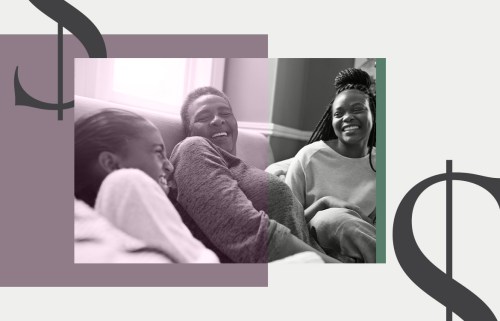I am a serious Beyoncé fan—in fact, I like to call myself “the Beyoncé of personal finance.” Just as she has a Beyhive of loyal supporters, my own organization, the Budgetnista, includes the Dream Catchers, a group of about 800,000 financial go-getters who are always ready to make financial moves with me.
And just when I thought I couldn’t love Beyoncé more, I heard her lyrics to “Boss”: “Ain’t nothing to it / I boss so I bought my momma a whip. / My great-great-grandchildren already rich.” In short, smooth lines, Beyoncé touches on the critical components for generational wealth: ownership and legacy.
Generational wealth is an accumulation of financial assets that are passed down and built upon in generations of a family. Also known as “legacy wealth” or “old money,” it affords families financial security and access to better education, health care, and job prospects—components that factor into living a healthy and well life. Wealth differs from income— which includes wages, salaries, and other incoming cash flow received by a person or household over some period of time—in that it includes ownership of stocks, assets, financial holdings, savings, and commonly includes a family home.
So, your income is what you earn, your wealth is what you own, and generational wealth is what you are able to pass down through your family line. Generational wealth is crucial for providing access to opportunities for forward mobility toward financial health and a well life.
Examples of generational wealth can include extreme wealth, like Blue Ivy Carter, daughter of Beyoncé and Jay-Z, inheriting a stake in Roc Nation, as Jay-Z describes on his 4:44 album. It can also be something less lavish, like inheriting a home or gaining access to other wealth-building assets, like family members helping with a down payment on a home or student loans, whether as a gift or a loan to be repaid at an interest rate lower than what banks offer. Whether what is passed down between generations is big or small, it’s always easier to build when you have something from which to build upon.
Many people, though—especially Black people—have little to nothing to build upon for reasons supported by systemic racism. According to the Center for American Progress, in 2016 “the median wealth for black households with a college degree equaled about 70 percent of the median wealth for white households without a college degree. The gap worsens as households grow older.” As the generational wealth gap has steadily widened, so too has the racial wealth gap, and that needs to change.
How the generational wealth gap supports unequal access to financial wellness
Racial wealth disparity factors are abundant and continue to widen. Barriers to equitable generational wealth for Black and Brown communities include policies that support systemic racism, like redlining and unequal interest rates, and lack of financial education resulting in financial literacy that lags behind that of the overall U.S. population.
Let’s take home ownership as one example of a wealth-building asset. A 2018 report by The Brookings Institute estimates that homes in majority-Black neighborhoods are undervalued by $48,000 on average, compared to similar homes in non-majority-Black areas. Cumulatively, this chronic undervaluing is estimated to cost Black homeowners $156 billion in what could have been passed down as generational wealth.
The obstacles keeping Black people from not only starting to generate wealth but even getting to place to start go beyond home values perpetuating and proliferating a broken and damaging system. It would take the average Black family 228 years and the average Latinx family 84 years to amass the amount of wealth enjoyed by the average white family, according to 2016 research from the Institute for Policy Studies. (Since 2016, the gap has likely only widened.) Additional factors that affect marginalized groups’ ability to build wealth include the Black bluff of Black employees being unsupported (and essentially set up to fail) in leadership positions at work, pay gaps, access to loans, and economic safety nets.
To illustrate how the generational wealth gap can affect wealth-building potential and future financial health, let’s examine the hypothetical stories of Sara and Sue.
Sara: a hard worker assisted by generational wealth
Sara attends college with her $80,000 tuition for a four-year degree covered by a family member. Right after college, Sara accepts an unpaid dream internship in New York City. While she does a great job and accordingly makes a positive impression on her employers, her parents cover her rent and expenses, saving her about $20,000.
Due to her hard work during her internship, Sara lands a job in her field, located in a neighboring state, making a starting salary of $80,000. Sara’s new salary qualifies her for a low-interest loan for a home, and her parents chip in $30,000 for the 10 percent down payment on a $300,000 property. By age 30, Sara has built on her wealth significantly through investing with money from her salary. Her net worth is $30,000 (and climbing).
Sue: a hard worker not assisted by generational wealth
Sue, Sara’s college roommate, works throughout her four years of college to help offset the $50,000 student loan she took out to cover tuition, room, and board. Sue is a brilliant student, but unpaid internships are not an option because she has no economic safety net to support her.
She takes the first job offered to her out of school, which pays $58,000, and she uses her salary to pay toward her student-loan debt. When she applies for a home loan, her debt is questioned and she’s deemed a risky candidate, ultimately penalized with a high-interest loan. She spends the next four years saving up $20,000 for a 10 percent down payment on a $200,000 home to bring down the loan amount. By 30, Sue is still paying off her student loans. Sue has a net worth of $7,000.
Despite the discrepancy in these numbers, Sara and Sue aren’t so different, aside from access to resources and opportunities to build wealth. Imagine if you added in a lack of financial literacy, inheritance, workplace salary discrimination, life insurance, and so much more. The gap in these numbers would be even more egregious.
4 steps for building generational wealth to generate future financial health
Even with all the challenges in the way, building wealth is essential—and possible. For example, more than 1 million of my Dream Catchers have taken my free Live Richer Challenges to tackle debt and create a foundation of wealth upon which future generations can build. We’ve budgeted and saved more than $200 million, which is proof positive that working to close the wealth gap is a worthy and productive exercise.
Below, find four suggestions anyone can take to start building wealth that can be passed down now.
1. Learn from members of your community
When I started the Budgetnista business, I did it with the intent that the people with whom I work would share their learnings with family members, friends, and community.
2. Nail financial literacy
You can’t do what you don’t know, so make financial literacy a priority by starting on your education young (or as soon as possible).
Join groups and communities that are focused on sharing practical financial education, and dig in! There are plenty around, but my personal favorite is a free one on Facebook that has over 450,000 motivated, generational-wealth-building Dream Catchers in it. (Hint, it’s my organization’s.)
3. Nix the shame
Instead of viewing money as a hush-hush topic never to be discussed—which is the case in many marginalized communities—talk freely and openly about changing the money mindset for those in your family and friend groups. Not to mention, research shows the gender pay gap often diminishes when employers adopt transparent pay practices. This means there is power in being open about money.
4. Take small steps that lead to larger ones
The best way to work toward closing the generational wealth gap? Start right now; don’t delay! Here’s some simple advice to remember along the way:
- Budget so you can save.
- Save so you can invest.
- Invest so you can create wealth.
In case it wasn’t there before, add “accumulate generational wealth” to your to-do list. Even though it’s absolutely unfair that obstacles in the way of working toward that goal exist to a varying magnitude depending on your personal background, do it anyway. And start today.
Oh hi! You look like someone who loves free workouts, discounts for cult-fave wellness brands, and exclusive Well+Good content. Sign up for Well+, our online community of wellness insiders, and unlock your rewards instantly.
Sign Up for Our Daily Newsletter
Get all the latest in wellness, trends, food, fitness, beauty, and more delivered right to your inbox.
Got it, you've been added to our email list.











